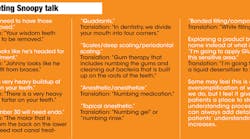Ban 'dentalese' to push through the language barrier
By Cappy C. Snider, RDH
A recent conversation was very confusing to me, and it prompted me to think about the "language" that different professions speak. My experience was with a mortgage banker. I'd called to investigate how refinancing our mortgage might benefit my family.
The gentleman I spoke with was very polite and courteous. He was speaking in "mortgage", though, and that is not a language I am at all familiar with. He would answer my questions with very technical terms. I would try to rephrase my question but got the same answer. The phone call ended with very little information exchanged and one very frustrated never-to-be (I'd already decided) customer! My short and very unproductive conversation reminded me of a scenario we often see in our dental operatories.
-------------------------------------------------
Other articles to consider reading:
- Using technology in pediatric dentistry to instill a lifetime of compliant dental care
- How to help patients want what they need
- Health literacy and the oral cancer exam
-------------------------------------------------
Conversations with the doctor regarding restorative work are often in "dentalese." As soon as the doctor leaves the room, the patient turns to you to ask, "What did he/she "say?" "Does that mean I have a cavity?"
We are then left to explain in layman's terms what was just said. Of course, we shouldn't stereotype the dentist for always being the one to speak over the patient's head. I've seen plenty of hygienists and assistants do the same thing. Our intent is not to confuse our patients. We get so caught up and comfortable, however, in our technical terminology that we forget our patients do not speak the language. My employer calls this "Snoopy talk." She is referring to the scenes in the Peanuts cartoons when Charlie Brown's teacher is talking to him, and all he hears is Wa-wah-wa-wa-wah-wah-wah!
Patient communication is one of the most important parts of our job. It does absolutely no good for the office or the patient if that patient leaves without a clear understanding of his or her oral condition and what we've suggested to restore oral health.
Our office has implemented a three-stage handoff in an attempt to avoid those situations.
After the doctor has finished her exam, she sits the patient upright to reiterate her findings. She tries to simplify the language into understandable terms for the patient (this sometimes goes into the territory of sugarcoating the message, but that's another article!) and answer all questions.
At the end of the hygiene appointment, I I once again tell the patient what the doctor recommended and answer any questions. We then proceed to the checkout counter, and, as I make my handoff of the patient, I tell the business staff member, in front of the patient, just what the doctor recommended once again. Of course, the business staff member already knows this from the treatment entered into the patient's record, but the patient gets to hear the treatment plan once again.
This makes three times that the patient hears the same thing. When we initially implemented this system, it did feel a bit awkward. Over time, it has become an easy part of our routine and eliminated a good bit of confusion. It also saves the business staff from using valuable time to explain clinical details to the patient and focus on making the financial arrangements to complete the treatment. It also gives the patient more time to think about any questions or concerns they might have and ask for clarification.
One other scenario to mention is just leaving information out altogether. A friend contacted me via email and related a situation she and her son experienced. Her 12-year-old son had decay diagnosed at a routine prophylaxis visit. It was his first cavity so he had no previous experience in the dental chair. At the restorative visit, he was reclined in the chair and a nitrous mask was placed on his face. Anesthesia was administered and the procedure completed. He was very shaken when they left.
His mom related to me that nothing was explained about how the nitrous would make him feel or what the mask was they were placing on his face. Since he'd never experienced local anesthetic, he was not prepared for the way his face felt or how his lip drooped like a sad dog's ears!
I'm sure this was an unintentional error by the dental staff. We get so comfortable and used to the language we speak in our profession that we forget that patients do not speak it also. Something that is so common and second nature to us is totally foreign to them.
My friend's email was a very good reminder of how we need to be aware of this with every patient and change our language to words and concepts they understand.
I cannot think of one single profession that does not have a language specific to what they do. Mechanics, plumbers, doctors, and lawyers use terminology that only they understand. So, next time you experience that language barrier in your operatory, step in and act as the interpreter. Heaven knows after hearing only "Snoopy talk" during my phone call with the mortgage banker, I wished I'd had one!
Cappy C. Snider, RDH, graduated from Tarrant County College in 1987. She is a homeschooling mom of two and has practiced continually for the last 27 years. She currently practices clinical dental hygiene with Dr. Brooke Porter of Azle Dental Care in Azle, Texas. Snider was named a Sunstar Butler Award of Distinction recipient in 2005. She may be reached by email at [email protected].
Past RDH Issues







